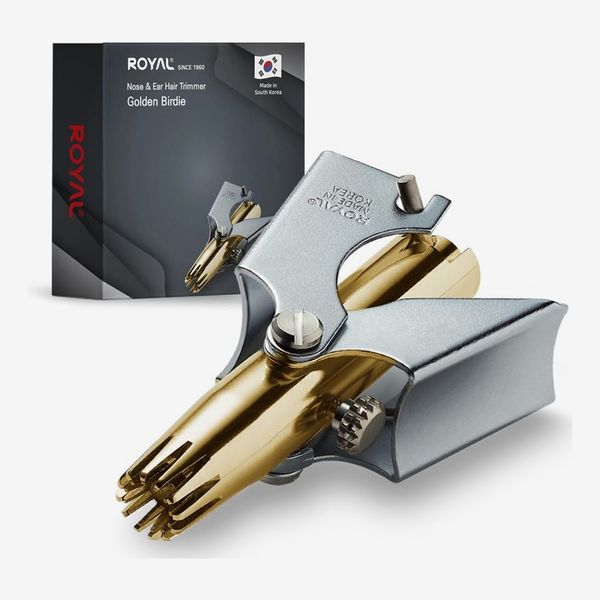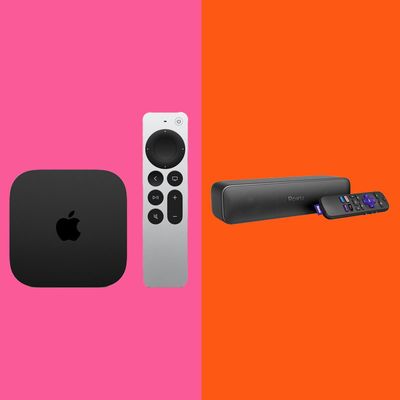
In this article
If you have a modern smart TV, you can probably run Netflix or Hulu right from the TV’s installed software. You probably shouldn’t, though, as most TVs collect a lot of your data and sell it to advertisers (and you can’t always restrict how much data they harvest). Streaming devices, on the other hand, usually either let you limit how much of your data is collected or don’t collect any data at all. And while smart TV interfaces are often slow and clunky, streaming devices typically have more robust and intuitive interfaces that put your content front and center.
You can also just do more with a dedicated streaming device. Unlike smart TVs, streaming devices let you install apps from an app store, which can expand the functionality of your TV to add apps for services like Letterboxd, Carrot Weather, and games like Dead Cells if you don’t want to have a dedicated console. They also have better voice controls that let you rewind or fast-forward, turn on subtitles, or start a new show without needing to use the remote.
I’ve been using various streaming devices in my home setup for over ten years and have been testing seven over the last four months to find the best options. I looked for devices with clean, intuitive interfaces, strong support for third-party apps, and reliable voice control for both convenience and accessibility.
What we’re looking for
Voice assistant
While remotes are the best way to interact with a TV, those with mobility issues — or anyone who prefers not to reach for the remote constantly — will appreciate being able to use voice commands for basic actions like play, pause, and rewind, as well as to search for content without typing on your TV’s remote. Some of these devices even have voice commands that make things faster than using a remote, like rewinding by 15 seconds and turning on subtitles to catch dialogue you missed all at once. The best streaming devices, though, have a built-in voice assistant that expands the capabilities to do things like answer questions, so you can ask the assistant about the show or movie you’re watching or, in some cases, even control your smart-home devices right from your TV, totally hands-free.
Exclusive content
While most streaming devices have access to all the major streaming services — Roku and Google both have access to Apple TV+ — that isn’t true of content bought within specific stores. For instance, if you buy a movie on iTunes, you can’t access it on Google TV. You can sometimes get around this by using AirPlay to cast content to a device, but DRM can often get in the way, so I noted which devices have proprietary content and what stores each device uses for that content.
AirPlay support
Apple’s AirPlay protocol allows you to stream content straight from your phone to your TV. It’s not proprietary to Apple, though; companies like Roku also support it, so you can use AirPlay in a pinch for content that isn’t available on any streaming services.
Ethernet connection
All streamers have Wi-Fi, but not all have the option to physically connect to your router. Those that do have an Ethernet port can achieve faster speeds than those operating on a wireless connection; this will help when streaming high-resolution content.
Home-screen ads
Many companies have incorporated ads into the home screens of their streaming devices without an easy way to disable them (if you can at all). Every streaming device has some form of advertising on the home screen, but some companies keep it to one section of the page, while others fill nearly your whole home screen with ads.
Data collection
Just like smart TVs, some streaming devices also collect data based on your downloading and streaming habits. In those cases, there’s usually an option to at least limit how much data gets collected, but ideally that amount should be zero. For each streaming device, I looked at what data gets collected and whether the company allows you to opt out of that collection.
Best streaming device overall
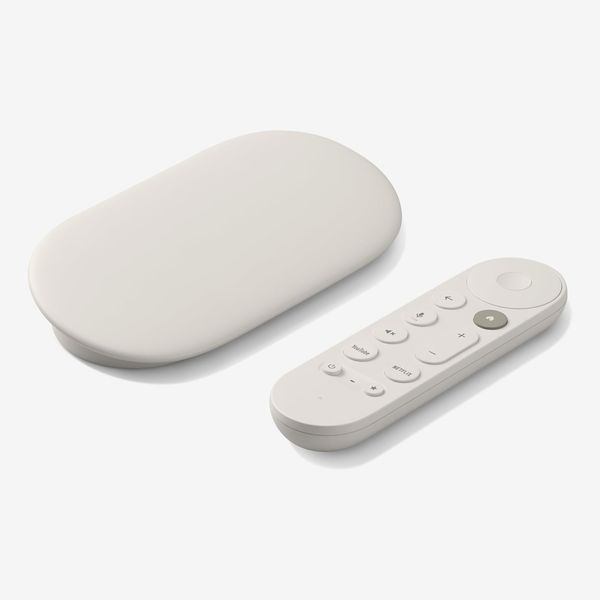
New! You can now save this product for later.
Voice assistant: Google Assistant | Exclusive content: Google Play | AirPlay support: No | Ethernet connection: Yes | Home screen ads: Three sections | Data collection: Yes, cannot limit or disable
If you want a streamer with intelligent software, apps for every service you watch videos on, and an eye-catching design, get Google’s TV Streamer 4K. It’s cheaper than the Apple TV while providing a similarly elegant interface and seamless experience.
Unlike the square shape of the Apple TV and many of Roku’s boxes, Google’s TV Streamer has a unique pill shape and angled top that can add more character to your TV stand than a black box. It’s also available in two colors — hazel and porcelain — which isn’t an option with any other streamer, where black is the default and often only choice. There’s also a button on the back that you can push to emit a loud beep from your remote, which can save you from tearing up the living room every time you misplace the remote.
Setting up the TV Streamer took less than ten minutes (including a five-minute software update). Once it’s plugged into your TV, you can download the Google Home app and use that to sign into your Google account on the Streamer. From there, signing into your streaming services is as simple as scanning a QR code and logging in via each service’s page on your smartphone. It’s not as quick as Roku’s synced logins, but it’s fast enough.
Navigating this streamer’s interface exemplifies everything good and bad about Google’s software. The actual interface looks great and provides an easy way to access all your favorite apps and shows. Google made its home screen the most useful of all the streamers by adding a “Continue Watching” section that displays all the shows (or YouTube videos) you haven’t finished watching so you can dive right back in. Frustratingly, though, this section is below two far less useful carousels. Atop the home screen is a nearly full-screen panel of rotating ads for movies and shows you can stream or buy, followed by a “top picks for you” section of content Google thinks you’ll like. Right now, mine is showing Fart: A Documentary. I’d rather just see a list of my apps, which requires at least three taps to get to, either scrolling down the “For You” page or scrolling to the “Apps” section and then scrolling past sponsored apps to access your app library.
Ads aside, Google’s interface is the most useful of the streamers I’ve tested. I’m especially fond of the control panel where you can automatically enable the screensaver (which you can set to a rotation of the pictures on your Google Photos account), change audio outputs, and connect to Bluetooth devices. If you have a pair of Google’s Pixel Buds Pro, you can connect them directly to your Google TV in the same way Apple devices (like the Apple TV) pair with AirPods: Simply open the case, and the option should pop up on your TV. I’ve found this especially handy for watching shows late at night when others in the house are still sleeping and I don’t want to rely solely on subtitles to catch all the dialogue. You can also use this panel to control smart-home devices like lightbulbs, thermostats, and security cameras.
In addition to the apps you’d expect to find on a TV — Netflix, Hulu, every other studio’s streaming service — there are some gems you won’t find on other TV platforms, including Apple’s. I’m a huge fan of having TikTok on my TV, which I’ve only been able to do natively on Google’s streamer. (With the Apple TV or Roku, you can only accomplish this by sharing your phone screen.) It seems silly at first, but after getting used to having vertical videos on my TV, I found myself spending less time on my phone and less time on TikTok overall. Now, it’s sort of a quick 15-minute viewing session before bed, rather than an endless scroll until 2 a.m.
Unlike the Apple TV and Roku Streaming Stick, Google’s streamer doesn’t support AirPlay 2. Because Google TV supports so many apps, this may not be an issue for many, but for those who like to cast from their phone or laptop, the Roku is a better option.
For media playback, Google’s voice control also isn’t as robust as Apple’s. For instance, you can’t say things like, “What did she say?” and have the streamer automatically rewind; instead, you have to say, “Rewind ten seconds” or something similar. It does, however, let you control your smart-home equipment with Google Assistant, so you can pause a show and dim the lights without having to lift a finger.
Unlike Apple, Google uses its streamer to collect a significant amount of data based on your habits. It monitors your streaming activity and content you’ve saved to your watch list, as well as your approximate location and app usage. You can disable location tracking, but everything else is fair game. While that data does theoretically improve what Google recommends to you on your home screen, it’s still an alarming amount of data to collect, and it would be nice if there were a way to disable it altogether. There is the ability to delete your advertising ID in Google TV’s privacy settings, but it’s only visible if you click on the “Ads” element in the menu, while every other element shows all the options immediately upon scrolling.
Best (less-expensive) streaming device

New! You can now save this product for later.
Voice assistant: No | Exclusive content: No | AirPlay support: Yes | Ethernet connection: No | Home screen ads: Three sections | Data collection: Yes, can disable
Roku’s Streaming Stick 4K doesn’t have all the bells and whistles of Apple or Google’s offerings, but it’s more affordable and still gets all the basics right. It is even better in some ways, like having faster setup and options for using wired headphones.
My favorite thing about Roku devices is that if you have a Roku account, you can sync your streaming services and log-ins across devices. It doesn’t work for every service — I was automatically logged into Hulu, but not Netflix or Peacock — but it’s nice when it works, as no other service has this feature. And although it’s not included (it’s an extra $30), I’m also a huge fan of Roku’s Pro remote, which has a built-in headphone jack. It’s not as convenient as using AirPods with an Apple TV or Pixel Buds with a Google TV as you’ll have to keep your remote close by, but it’s not proprietary either, so you can use it with any pair of wired earbuds you have lying around. And if you don’t want to splurge for the remote or be tethered to the remote, you can stream the audio directly to your smartphone using Roku’s app and listen with your Bluetooth headphones that way or just pair them directly to the Roku.
Of all the streaming devices I’ve tested, Roku’s software is the simplest but often the least helpful. The home page has two main sections: a carousel of curated content Roku thinks you might enjoy, and a grid of all the apps you’ve installed on your device. Unlike the Google TV, you won’t be able to see a list of recently viewed content on your Home Screen. This is accessible via Roku’s “What to Watch” menu, but it requires seven clicks on the remote, while Google’s only requires five.
Compared to the Apple TV and Google TV’s interfaces, Roku’s is clunky and frustratingly slow. When typing on the onscreen keyboard, I had to slow down my finger movements to ensure the device registered every click on my remote, which neither the Google nor Apple streamers did. Although the results are usually accurate, there’s also a noticeable delay in the Roku’s ability to pick up audio for voice control: Sometimes it seemed as though the voice control didn’t trigger and I’d try again, only for it to start and then immediately stop.
While Roku does track a lot of your data, I’m impressed with its more thorough privacy settings compared to the other devices on this list. Inside the privacy menu is a section where you can block sensitive ad content — horror, substance use, violence — and disable personalized ads. There are also sections to disable speech recognition and microphone access, as well as having the option to block the sharing/selling of your information altogether.
Best streaming device for Apple households
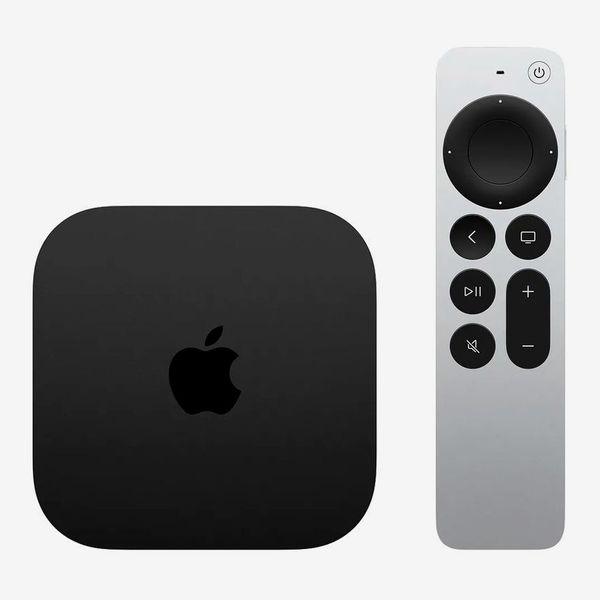
New! You can now save this product for later.
Apple TV 4K
Voice assistant: Siri | Exclusive content: iTunes | AirPlay support: Yes | Ethernet connection: Yes | Home screen ads: One section | Data collection: Yes, can disable
No other streaming device feels as polished as the Apple TV. Its interface is clean and intuitive compared to Google TV’s more cluttered home screen. If you’ve spent any time with an iPhone or iPad, you’ll feel right at home on Apple’s tvOS. The home screen is a simple stack of app icons you select from, and it’ll jump you straight into the app, and unlike Google’s TV, Apple doesn’t put any ads on the home screen. Inside Apple’s TV app — which is confusingly both a hub for Apple TV+ content and a way to view content across all the services you’re logged into — is a “Continue watching” section similar to Google’s, but it’s tucked inside an app instead of on the home screen.
The latest Apple TV has a new remote that replaced the previous model’s controversial glass trackpad with a directional pad that doubles as a touch panel. I’ve found the touch panel to be more intuitive, and it works better for video scrubbing. On the other hand, some members of my family loathe the sensitivity of the touchpad and prefer to use the hardware buttons on the remote. Thankfully, you can turn the touchpad off entirely, depending on your preference. If you have an iPhone or iPad, you can also use those to control the TV, which is especially handy if you’re prone to losing your remote.
Like other Apple products, the Apple TV has Siri built in. It’s about as reliable as on other devices, but Apple added some key features that I wish it did a better job of highlighting. My favorite is being able to ask Siri, “What did they just say?” and have the video I’m watching rewind 15 seconds and enable subtitles just for the part I missed.
If you’re not in the Apple ecosystem, the Apple TV is still an excellent streamer and you won’t be missing out on its greatest strengths, but having other Apple devices does bring some extra benefits to the Apple TV. For instance, you can cast your iPad, iPhone, or Mac display straight to your TV if you want to share a TikTok with your friends or show a livestream there isn’t an app for. You can also use your TV as a display for FaceTime calls and prop your phone’s rear camera up, facing you, to give your recipient a better image than the front-facing camera allows. Finally, if you have any of Apple’s AirPods or HomePods, it’s easy to cast the audio straight to those devices, and you can even have the sound output to multiple channels.
Even with all of its refinement and impressive features, the Apple TV’s price is still tough to stomach when there are much cheaper options available that offer roughly the same basic functionality. The entry-level model, which lacks an Ethernet port, is $30 more expensive than the Google TV (which does have an Ethernet port), and Apple charges an extra $20 for a model with that same port.
Best streaming device and soundbar
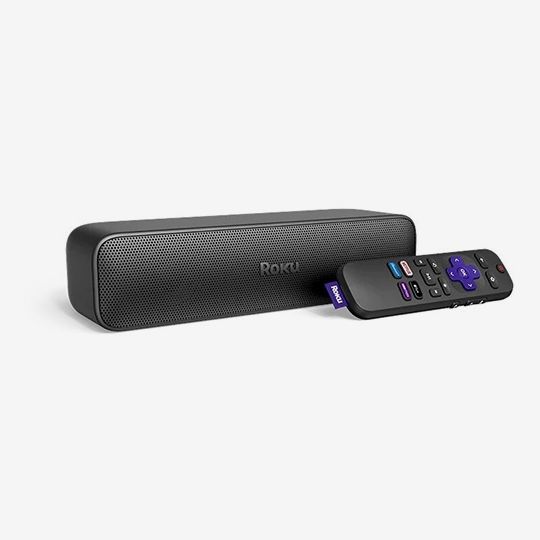
New! You can now save this product for later.
Voice assistant: No | Exclusive content: No | AirPlay support: Yes | Ethernet connection: No | Home screen ads: Three sections | Data collection: Yes, can limit
If you hate having to crank up your TV’s volume to catch quiet dialogue but don’t have space for or want to splurge on a dedicated soundbar, get Roku’s Streambar SE. In addition to being a good Roku device — it functions exactly the same as the Streaming Stick — it’s also a perfectly adequate soundbar. The sound isn’t as good as what you’d get from even budget soundbars, but it’s leagues ahead of what any TV’s speakers are capable of. Roku’s software even has a night mode that will automatically lower the volume of loud sounds like explosions and crashes and raise the volume of soft sounds like whispers.
More From The Strategist
- Ask Kim France: I’m Really Confused About Pants!
- An Advent Calendar for Every Kind of Person
- I’ve Been Sleeping So Well Since I Started Spraying Magnesium on My Feet
- The Best Clean Anti-Aging Skin-care Routine, According to Experts
The Strategist is designed to surface useful, expert recommendations for things to buy across the vast e-commerce landscape. Every product is independently selected by our team of editors, whom you can read about here. We update links when possible, but note that deals can expire and all prices are subject to change.




